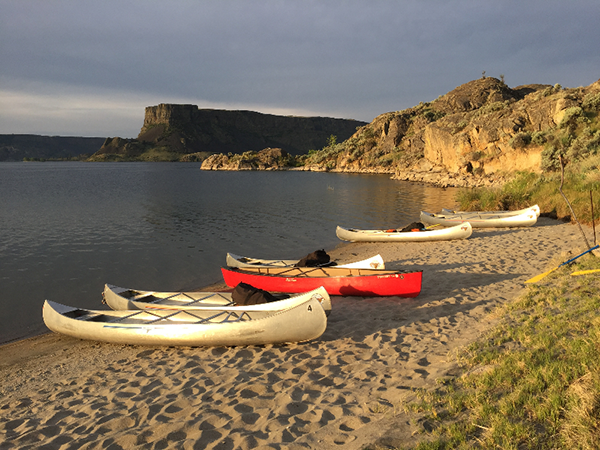For most climbers, springtime means eagerly heading to the nearest crag to chase away the winter blues. Although short drives are appealing, adding a small amount of driving time can yield even more diverse climbing destinations. Only 2 hours west of Spokane, near Grand Coulee, lies Banks Lake. An overflow reservoir used to generate power at Grand Coulee, the lake is surrounded by granite outcroppings ranging up to 500 feet high.
Quite simply put, Banks Lake is beautiful, and there’s no better time to explore its crags than in the spring. With many climbs facing south, catching rays of sunshine is easy in March, April, and May. Most climbs can be hiked into, while some can be approached by boat or canoe, making Banks Lake a unique climbing destination. In terms of climbing style, most of the climbing is either vertical or slab, with routes ranging in length from one to five pitches.

But what makes Banks Lake so special? Many members of the climbing community would say that Banks Lake has the best collection of 5.9s and 5.10s in the state. With five designated climbing areas that offer variance in both difficulty and climbing style, there is no shortage of routes to choose from.
Highway Rock is most aptly described as a massive piece of granite. Towering at 300 feet, it has more than 70 climbs that face southeast, southwest, northwest, and north, which makes it easy to chase the welcome rays of springtime sun. As this area and Northrup Canyon lie on state park land, bring a Discover Pass. Golf Course Rocks is an almost-perfect granite outcropping that houses nearly a dozen routes, most ranging in difficulty from 5.7-5.10d.
Northrup Canyon is highly recommended by Rick La Belle, author of the guidebook “Rock Climbs of Central Washington.” La Belle has done most of the development in the area from 1996-2005, and says Picnic Table Rock at Northrup Canyon is the go-to crag for first time visitors. With a wide variety of climbs ranging in difficulty from 5.6-5.13, Picnic Table Rock will not disappoint. La Belle recommends Dr. Ceuse, 5.10 as one of the must-do classics in the area. Those with a fondness for slab climbing should head to Gibraltar Rock, another crag at Northrup Canyon, to climb How Homer Got His Groove Back—a 13-bolt 5.10b slab with plenty of crimps to go around.

For those climbers searching for even more adventure, reaching the Peninsula requires four-wheel-drive and a rugged hike in. A better approach is to canoe or boat two miles across Banks Lake from the State Park boat ramp to the Peninsula’s numerous crags. Many climbers will canoe across and camp on the beach, making for an unforgettable multi-day trip. All of the climbs at the Peninsula are south-facing, which means warm climbing in the spring. Post-Modern Wall at the Peninsula has both single and multi-pitch routes, but the real exposure and five-pitch routes come from the Orange Walls.
A copy of “Rock Climbs of Central Washington,” some climbing gear, a good partner, and an eye out for poison ivy and rattlesnakes are all that’s needed for a successful day of cragging. With spring comes renewed enthusiasm, and Banks Lake is the perfect destination for climbers looking to start the season off strong.
Originally published as “Chasing Spring at Banks Lake” in the April 2018 issue.
[Feature photo: Sara Moeser climbs high above Banks Lake. // Jon Jonckers]













